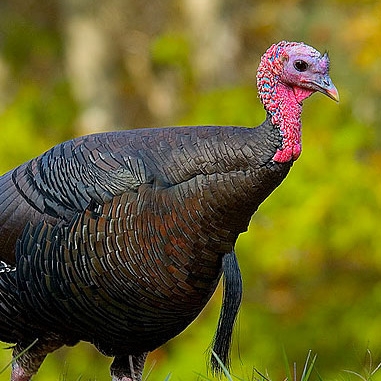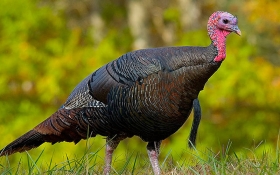
Wild Turkey
Meleagris gallopavo
Animal Behavior: Wild turkeys are diurnal and non-migratory. By day, they can be seen grazing in fields and woodlands. At night, they roost in trees. Wild turkeys are generally wary, and have keen eyesight and hearing. They are swift runners and fast fliers. Turkeys have been recorded flying at 88.5 km/h. Turkeys are social. During the winter, they form bands in which dominance hierarchies may develop. In some populations, each band may defend a territory against other bands.
Eating Habits: Wild turkeys are omnivorous. They primarily eat vegetable matter such as acorns, nuts, seeds, buds, leaves and fern fronds. They also eat ground-dwelling insects and salamanders, which account for about 10% of their diet.
Range: Wild turkeys (Meleagris gallopavo) are one of the most widely distributed game bird species in North America. They are found throughout most of the eastern United States, and in pockets throughout the western United States.
Conservation Efforts: Wild turkeys are plentiful and are widespread. Many states are starting to introduce them into previously uninhabited areas, increasing their range and distribution. Current estimates of wild turkey populations are around 4 million in North America
Animal Facts: Wild turkeys are polygynous. Males attempt to attract females by "gobbling" and &ldquostrutting&rdquo. They raise one brood per season. The nest is a shallow depression in the ground, usually surrounded by dense brush, vines, tangles, deep grass, or fallen tree tops. The female scratches out the nest and lays 4 to 17 (usually 8 to 15) eggs. They can live for about 13 years but typically only survive 1-2 years.
